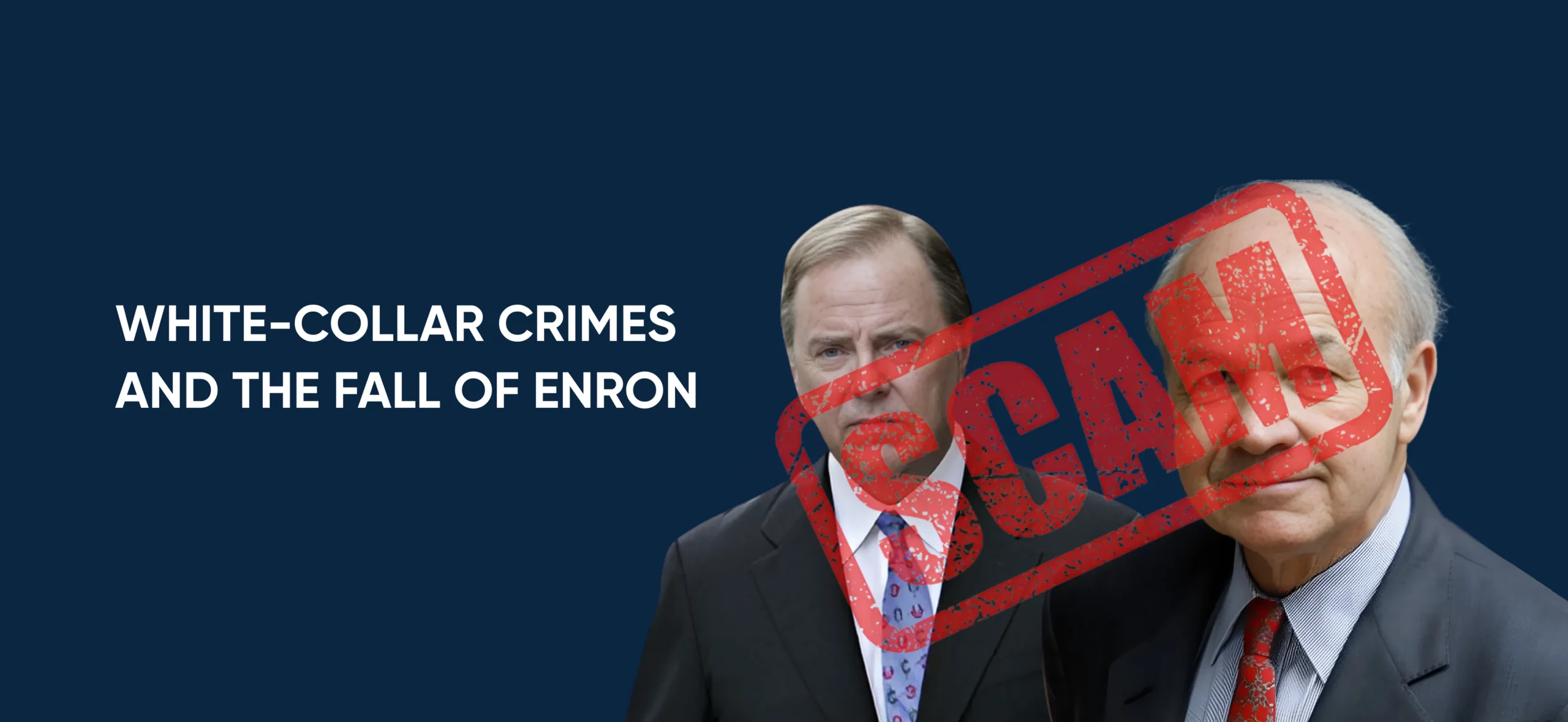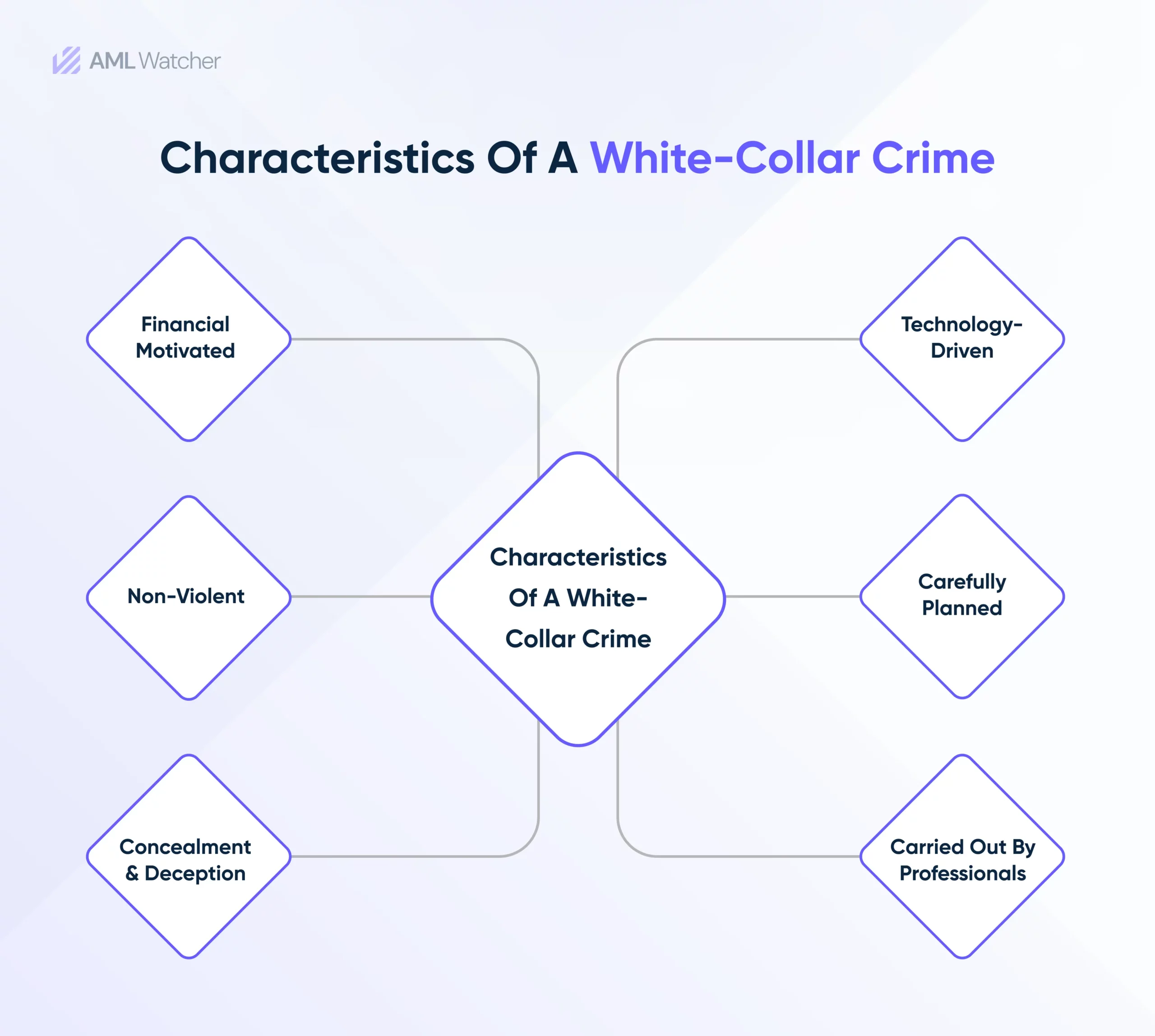
What are White-Collar Crimes? Insights From the Enron Scandal
The notion that white-collar crime is a modern invention is a misconception. It has been part of our society for centuries. Back in 1939, it was Edwin Sutherland who first coined the term “white collar crime”.
The first documented case of white collar crime probably occurred in England back in the 15th century since England is the first country where capitalism flourished and an industrialized society emerged.
White collar crimes don’t always have obvious perpetrators and victims. Although they might be challenging to identify and prove, white-collar crimes like money laundering, fraud, bribery, and embezzlement allow people to make more money than they currently do.
What Is a White-Collar Crime?
White collar crimes, as the name suggests, involve nonviolent deception, manipulation, and concealment for financial or business advantage, such as gathering assets or money.
Usually, people from higher social classes or those employed in white-collar jobs belong to the class. This is crucial because someone in a position of authority is needed to commit white-collar crimes.
Very few white-collar crimes result in serious physical harm to victims. Rather, the lack of money coming back into the economy is what causes society to suffer.
Although the effects of white-collar crime are extensive, they are not immediate or evident. Years may pass before someone is apprehended, if at all.
It’s common to use the terms white collar crimes and money laundering interchangeably.
White-collar crimes include embezzlement, securities fraud, corporate fraud, and money laundering. Among the agencies that investigate white-collar crimes are the Securities and Exchange Commission (SEC), the Financial Industry Regulatory Authority (FINRA), the FBI, and state authorities.
Top 6 Types of Collared Crimes
Crimes occur in different shapes or forms. Let’s discuss some forms of it.
Blue-collar crime
The term “blue collar” refers to crimes perpetrated by individuals who are of the working or middle class or lower social classes.
These are more aggressive and carried out by individuals against particular groups of people or companies.
Theft, burglary, vandalism, shoplifting, sexual assault, illicit drug trafficking, prostitution, murder, and other violent crimes can all fall under this category.
Blue collar crimes are more visible, and hence receive more active police attention. These often have a definite victim and offender, and there are consequences for both parties.
Black-collar crime
Molestation of kids and other sexual attacks on congregations, as well as scams perpetrated by preachers and clergy, may be considered “black collar” crimes.
This could include stealing, money laundering, and child molestation. This is not an official term in the United States. This is used to characterize a crime in an unauthorized setting, such as with the press, victims, or clients.
Red-collar crime
A white collar crime transforms into a red collar crime when the perpetrator becomes violent. This can be assassinating a witness in a fraud trial in order to silence them or killing a journalist, investigator, or whistleblower who revealed the fraud. Red collar crime was defined by Perri and Lichtenwald as follows:
Because they operate in both the realms of violent and white-collar crime, this subgroup is known as red-collar criminals. When there is a chance of being discovered, red-collar criminals will resort to violent activities in order to intimidate those who have discovered their deception and to stop more information from being shared.
Red collar crime was defined by Perri and Lichtenwald as follows:
“Because they operate in both the realms of violent and white-collar crime, this subgroup is known as red-collar criminals. When there is a chance of being discovered, red-collar criminals will resort to violent activities in order to intimidate those who have discovered their deception and to stop more information from being shared.”
As per the 2018 data by the Bureau of Labor Statistics, workplace homicide ranks third among the leading causes of mortality in the United States.
Ironically, narcissism and psychopathy are considered desirable features in the recruitment process, according to an article in The Atlantic magazine on red collar criminals. despite the possibility that a business may hire a white collar criminal as a result.
Organized transnational crime
Because organized crime transcends national borders, it is known as organized transnational crime.
As a result of technological and transportation advancements, law enforcement agencies and governments have had to combat this type of crime on a global basis.
Cybercrime, terrorism, illegal arms sales, drug smuggling, money laundering, and human trafficking are a few examples.
Even though it’s impossible to measure transnational crime exactly, in 2009 the worldwide think tank Millennium Project compiled data on a number of related topics:
- Global illicit trade valued at around $780 billion
- Piracy and counterfeiting worth between $300 billion and $1 trillion
- The $321 billion global drug trade
State-corporate crime
State-corporate crime is defined as “illegal or socially harmful actions that take place when one or more political governance institutions work directly with one or more institutions of economic production and distribution to pursue a goal.”
An almost entirely white-collar “situation” that presents a chance for criminality is the negotiation of agreements between a state and a firm, which will take place at a relatively senior level on both sides.
Evidence reveals that white-collar crime remains a low priority, despite law enforcement’s assurances to the contrary.
Control fraud refers to the practice of senior corporate officials engaging in illegal activities using the company.
Corporate crime
Instead of benefiting individuals, corporate crime serves the interests of the corporation (company or other sort of commercial entity).
However, it might be the consequence of choices made by powerful people in the company. Unlike individuals, corporations do not face criminal court litigation, hence the term “crime” is not actually applicable.
Typically, civil courts or organizations with authority over particular offenses handle litigation.
One example of such an organization is the U.S. Securities and Exchange Commission, which handles cases involving financial market and investment statute violations.
White Collar Crime – Case of Enron Corporation
Among the most notorious episodes of corporate fraud in American history, the Enron scandal is a prime illustration of white collar crime cases.
In addition to causing investors to suffer large financial losses, the fall of Enron Corporation also resulted in extensive legal repercussions, regulatory changes, and a review of corporate governance procedures.
This case study explores the complexities of the Enron lawsuit, emphasizing the major incidents, court cases, and long-term effects of the scandal.
The Rise and Spectacular Fall of the American Energy Giant
Established in 1985 by the union of Houston Natural Gas and InterNorth, Enron Corporation was once a behemoth in the energy industry.
Kenneth Lay, the company’s CEO, oversaw Enron’s quick expansion, diversification into other energy-related businesses, and invention of novel trading techniques.
As one of the most inventive businesses in America by the late 1990s, Enron had a market valuation of more than $60 billion.
Enron, however, was involved in a number of intricate and dishonest accounting techniques intended to inflate its earnings and conceal its rising debts behind the company’s successful façade.
Mark-to-market accounting and special purpose companies (SPEs) enabled Enron to alter its financial statements, misleading analysts, investors, and regulators.
The Downfall
After a number of investigative reports by journalists and financial analysts started to highlight inconsistencies in the company’s financial statements in late 2001, Enron’s collapse really got under way.
Enron revealed the presence of over $1 billion in previously undisclosed debt on October 16, 2001, along with a significant third-quarter deficit. The stock price of Enron fell precipitously and investor confidence rapidly declined as a result of this news.
Enron filed for bankruptcy on December 2, 2001, making it the largest corporate bankruptcy in American history at the time.
Huge financial losses for workers, investors, and pensioners resulted from Enron’s collapse, which also caused Enron’s auditor Arthur Andersen, one of the biggest accounting companies in the world, to dissolve.
The Litigation
A slew of litigation lawsuits that targeted the corporation and its officials followed the Enron scandal.
As a result of their roles in the fraud, prominent individuals like Kenneth Lay, Jeffrey Skilling (the COO and eventually CEO of Enron), and Andrew Fastow (the CFO) faced criminal prosecution.
Kenneth Lay, one of the founding members, was found guilty on several charges in 2006 of conspiracy, securities fraud, and making false statements.
But prior to being sentenced, he suffered a heart attack, which resulted in the conviction being vacated.
Jeffrey Skilling received a 24-year jail sentence after being found guilty in 2006 of conspiracies, securities fraud, and insider trading. In 2019, he was freed after having his sentence lowered to 14 years.
Andrew Fastow, the mastermind behind many of Enron’s fraudulent operations, pleaded guilty to conspiracy and was sentenced to six years in jail in 2006.
He cooperated with prosecutors, supplying crucial evidence against his former colleagues.
How to prevent white collar crimes?
Understanding the distribution of white collar crime is critical, but so is implementing proactive tactics that detect possible dangers and prevent these sophisticated misdeeds from ruining a company’s reputation.
Here are some approaches to detecting and preventing white-collar crimes.
Whistleblower Programs
Establishing strong whistleblower programs encourages employees and stakeholders to report suspicious or unethical behavior.
Whistleblower anonymity ensures a safe environment for reporting and serves as an effective tool in identifying internal white-collar offenses.
Internal controls and audits
The implementation of tight internal controls, together with regular audits, guarantees that financial operations are transparent.
These measures not only prevent prospective white-collar criminals within the firm, but they also provide critical insights into areas that are vulnerable to exploitation.
Compliance not only reduces legal risks, but it also fosters a culture of accountability, discouraging both internal and external fraud.
AML Watcher is committed to making sure that organizations can appropriately manage and resolve dynamic AML concerns.
Contact us for more information, or speak with one of our experts to acquire a FREE demo of the screening solution feature you require.
Book Free DemoWe are here to consult you
Switch to AML Watcher today and reduce your current AML cost by 50% - no questions asked.
- Find right product and pricing for your business
- Get your current solution provider audit & minimise your changeover risk
- Gain expert insights with quick response time to your queries




